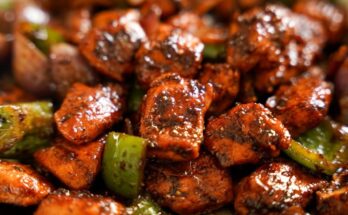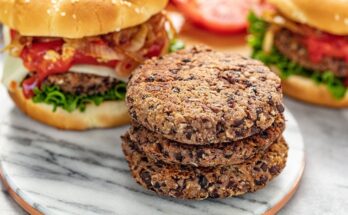Hawaiian Bread Recipe: Hawaiian bread isn’t just bread—it’s a warm, soft, slightly sweet piece of heaven that can instantly transport you to the islands with its tropical flavor. Unlike regular bread, Hawaiian bread has a unique sweetness that comes from pineapple juice or sugar, giving it that signature taste many people know and love. Whether you’ve had it at a family gathering, in a restaurant, or straight from the bakery, you know that Hawaiian bread is in a league of its own.
So, what makes Hawaiian bread so irresistible? For starters, it has the perfect balance between sweetness and softness. It’s fluffy but not overly airy, slightly chewy yet still delicate. It pairs beautifully with both savory and sweet dishes, making it one of the most versatile bread recipes you can try at home.
The history of Hawaiian bread dates back to the Portuguese immigrants who brought their sweet bread recipes to Hawaii in the 19th century. Over time, locals added their own tropical twist, often incorporating pineapple juice to give it that island-inspired flavor. Today, Hawaiian bread is a household favorite and is sold worldwide.
The best part? You don’t need to be a professional baker to make it. With a few ingredients and some patience, you can bake your own homemade Hawaiian bread that tastes just as good (if not better) than store-bought versions. This recipe is foolproof, and I’ll walk you through every single step so you can enjoy fresh, homemade Hawaiian bread whenever you like.
Ingredients You’ll Need
Like most baking recipes, Hawaiian bread starts with simple pantry staples. What makes it different is the unique combination of sweetness and richness that transforms ordinary bread dough into something extraordinary. Here’s a breakdown of what you’ll need:
Core Ingredients for the Dough
- All-purpose flour (about 5 cups) – the backbone of your bread.
- Instant yeast (2 ¼ teaspoons) – ensures the bread rises beautifully.
- Salt (1 teaspoon) – balances the sweetness and enhances flavor.
Sweeteners and Flavor Enhancers
- Pineapple juice (1 cup, room temperature) – the secret ingredient for that tropical sweetness.
- Granulated sugar (½ cup) – adds sweetness and feeds the yeast.
- Honey (2 tablespoons) – boosts flavor and moisture.
- Unsalted butter (4 tablespoons, melted) – enriches the dough and keeps it soft.
- Eggs (2 large) – help bind the dough and give it structure.
Optional Add-Ins for Creativity
- Coconut flakes – for a tropical twist.
- Orange zest – adds brightness.
- Raisins or dried pineapple – for extra sweetness.
Each ingredient plays a vital role. The flour gives structure, the yeast makes it rise, and the pineapple juice gives it that signature taste. When combined, they create bread that is slightly sweet, incredibly soft, and impossible to resist.
Essential Tools and Equipment
Before diving into the actual baking, let’s talk about tools. You don’t need a fancy kitchen setup to make Hawaiian bread, but having the right equipment makes the process smoother.
Baking Tools You Can’t Skip
- Large mixing bowl – to bring everything together.
- Wooden spoon or silicone spatula – for mixing.
- Dough scraper – makes handling sticky dough easier.
- Loaf pans or round baking pans – depending on whether you’re making a loaf or rolls.
Measuring Tools for Accuracy
- Dry measuring cups for flour and sugar.
- Liquid measuring cup for pineapple juice.
- Measuring spoons for salt, yeast, and honey.
Substitutes for Professional Equipment
Don’t have a stand mixer with a dough hook? No problem! You can knead the dough by hand. No bread pan? Use a baking sheet lined with parchment paper and shape your dough into rolls. Hawaiian bread is very forgiving, so even if you improvise, you’ll still end up with a delicious result.
Step-by-Step Guide to Making Hawaiian Bread
Now, here comes the fun part—actually baking your Hawaiian bread! Follow these steps carefully, and you’ll be rewarded with soft, sweet, golden-brown bread that’s guaranteed to impress.
Step 1 – Preparing the Yeast
In a small bowl, combine warm pineapple juice (about 110°F), sugar, and yeast. Stir gently and let it sit for 5–10 minutes until foamy. This step activates the yeast and ensures your bread rises properly. If it doesn’t foam, your yeast might be dead—start over with fresh yeast.
Step 2 – Mixing the Dough
In a large mixing bowl, combine flour, salt, eggs, honey, butter, and the yeast mixture. Mix until a shaggy dough forms. Don’t worry if it looks messy at first; it will come together as you knead.
Step 3 – Kneading to Perfection
Turn the dough onto a floured surface and knead for 8–10 minutes until smooth and elastic. If you’re using a stand mixer, let it knead with the dough hook for about 6 minutes. This step develops the gluten, which gives your bread its chewy, soft structure.
Step 4 – First Rise (Proofing the Dough)
Place the dough in a greased bowl, cover with a damp cloth, and let it rise in a warm spot for 1–2 hours or until doubled in size. This is where the magic happens—the yeast feeds on the sugar and pineapple juice, creating those airy bubbles inside the dough.
Step 5 – Shaping the Bread
Once the dough has risen, punch it down gently to release air. Divide it into equal portions and shape into rolls or place it into a loaf pan. The shaping is entirely up to you—both styles bake beautifully.
Step 6 – Second Rise (Final Proof)
After shaping, place the dough portions onto a greased baking sheet or inside loaf pans. Cover them loosely with a kitchen towel and let them rise again for 45–60 minutes, or until they’ve doubled in size. This second rise is what gives Hawaiian bread its light, pillowy texture. If you skip this step or cut it short, the bread will come out dense and heavy. Think of this stage as letting the dough relax and breathe before hitting the oven.
A good trick is to place the shaped dough in an oven that’s turned off but with the light on. The gentle warmth helps the yeast thrive without overdoing it. Once you see the dough puff up nicely and almost look like marshmallows, you’ll know it’s ready for the next step.
Step 7 – Baking the Bread
Preheat your oven to 350°F (175°C). Brush the tops of the rolls or loaf with an egg wash (a mix of beaten egg and a splash of milk) to give them a beautiful golden-brown finish. Bake for about 25–30 minutes for rolls or 35–40 minutes for a loaf, until the tops are golden and the bread sounds hollow when tapped on the bottom.
The aroma will fill your kitchen with hints of butter and sweetness—it’s nearly impossible not to sneak a piece straight from the oven! But patience pays off, as Hawaiian bread is best when cooled slightly.
Step 8 – Cooling and Serving
Once baked, remove the bread from the oven and let it cool on a wire rack for at least 20 minutes. This cooling period allows the interior to finish cooking and prevents the bread from becoming gummy when sliced.
Now comes the best part: serving! You can slice it up and serve warm with butter, use it for sliders or sandwiches, or even toast it with a drizzle of honey. Hawaiian bread is also amazing with pulled pork, turkey sandwiches, or as a base for French toast.
Tips for the Perfect Hawaiian Bread
Making Hawaiian bread is simple, but these little tips can elevate your baking game and ensure consistent results every time:
Getting the Right Sweetness Level
Some people like their bread extra sweet, while others prefer it mild. If you want a more dessert-like bread, increase the sugar slightly. For a less sweet version (great for sandwiches), reduce the sugar by a tablespoon or two.
How to Make the Bread Extra Fluffy
The key to fluffy bread is proper kneading and proofing. Don’t rush the process. If your dough doesn’t double during rising, the yeast may need more time. Also, avoid adding too much flour during kneading—sticky dough is okay, and it will smooth out as you work it.
Storing and Reheating Properly
Hawaiian bread tastes best fresh, but you can keep it in an airtight container at room temperature for up to 3 days. For longer storage, freeze it in a ziplock bag for up to 2 months. When reheating, wrap in foil and warm in the oven at 300°F for 10 minutes to bring back its softness.
Variations of Hawaiian Bread
One of the best things about this recipe is how adaptable it is. You can tweak it to suit your preferences or dietary needs.
Mini Hawaiian Rolls
Instead of making one large loaf, divide the dough into smaller balls and bake them in a 9×13-inch pan. This way, you’ll get fluffy pull-apart rolls perfect for parties, burgers, or sliders.
Whole Wheat Hawaiian Bread
For a healthier twist, replace half of the all-purpose flour with whole wheat flour. The bread will be slightly denser but still delicious and full of nutty flavor.
Vegan-Friendly Version
Yes, you can make Hawaiian bread vegan! Replace the eggs with flaxseed eggs (1 tablespoon ground flaxseed + 3 tablespoons water = 1 egg). Swap butter for coconut oil or vegan margarine, and you’ll have a plant-based version that still tastes incredible.
Common Mistakes and How to Avoid Them
Even the best bakers face challenges. Here are common pitfalls to watch out for when making Hawaiian bread:
Flat Bread Issues
If your bread doesn’t rise, your yeast might be expired, or the liquid you used was too hot, killing the yeast. Always check the expiration date and aim for lukewarm liquid, not hot.
Overproofing or Underproofing
Proofing is crucial. If you let the dough rise too long, it can collapse during baking, leaving flat or wrinkled bread. If you don’t let it rise enough, the bread will be dense. The trick? Use the “poke test”: gently press the dough with your finger. If it springs back slowly, it’s ready.
Overly Dense Texture
Too much flour during kneading is the usual culprit. Hawaiian bread dough should feel soft and slightly sticky. Resist the urge to add too much flour, and you’ll be rewarded with a lighter loaf.
Serving Ideas for Hawaiian Bread
Hawaiian bread is versatile, which makes it the perfect addition to almost any meal. Because of its unique sweetness and fluffy texture, you can serve it in countless ways:
As a Side Dish for Meals
Freshly baked Hawaiian bread pairs wonderfully with savory dishes. Serve it alongside roasted chicken, grilled meats, or a hearty stew. The slight sweetness balances salty and spicy flavors beautifully, making it an excellent side for dinner parties or holiday feasts.
Using Hawaiian Bread for Sandwiches
One of the best uses of Hawaiian bread is for sandwiches. Imagine a soft bun holding juicy pulled pork, grilled chicken, or turkey with cranberry sauce—it’s pure perfection. The bread’s sweetness elevates ordinary fillings into gourmet-level sandwiches. For sliders, shape the dough into smaller rolls, and you’ve got the perfect party food.
Dessert Ideas with Hawaiian Bread
Hawaiian bread isn’t just for savory dishes—it can transform into a dessert too. Try making bread pudding with it for a rich, custardy treat. Or toast slices and top them with Nutella, fruit, or whipped cream. You can even turn it into French toast, where the sweet, spongy bread soaks up the egg mixture beautifully and caramelizes when cooked.
Nutritional Value of Hawaiian Bread
While Hawaiian bread is undeniably delicious, it’s important to understand its nutritional profile.
Calories and Macronutrients
A typical slice of Hawaiian bread (depending on size) contains around 90–120 calories. It provides carbohydrates for energy, some protein from the eggs, and a small amount of fat from butter or oil.
Health Benefits of Ingredients
- Pineapple juice adds vitamin C and a natural sweetness.
- Eggs contribute protein and essential vitamins.
- Honey provides antioxidants and a touch of natural sugar.
Of course, since Hawaiian bread is on the sweeter side, moderation is key. Think of it as an occasional treat rather than an everyday staple.
Moderation and Balance
Enjoy Hawaiian bread as part of a balanced diet. Pair it with protein-rich dishes or veggies to balance out the carbs. If you’re watching your sugar intake, try the whole wheat variation or reduce the sugar slightly.
FAQs about Hawaiian Bread Recipe
Can I Freeze Hawaiian Bread?
Yes! Hawaiian bread freezes beautifully. Wrap it tightly in plastic wrap, then place it in a freezer-safe bag. When ready to enjoy, thaw at room temperature or reheat in the oven.
How Long Does It Stay Fresh?
Homemade Hawaiian bread stays fresh for about 3 days at room temperature when stored in an airtight container. For longer storage, freezing is the best option.
Can I Make It Without Eggs?
Absolutely! You can replace eggs with flaxseed eggs or unsweetened applesauce. The texture will be slightly different but still soft and tasty.
Do I Have to Use Pineapple Juice?
Pineapple juice gives Hawaiian bread its signature flavor, but you can substitute with orange juice or apple juice if you don’t have any on hand.
Can I Use This Recipe in a Bread Machine?
Yes. Most bread machines have a “sweet bread” setting that works perfectly for Hawaiian bread. Simply add the ingredients in the order recommended by your machine’s manual.
Conclusion
Hawaiian bread is more than just bread—it’s a little taste of the tropics right from your oven. With its soft texture, hint of sweetness, and golden crust, it’s perfect for everything from family dinners to holiday gatherings. The best part is, you don’t need fancy tools or years of baking experience to make it at home. Just follow the steps, take your time with the rises, and you’ll have a bakery-worthy loaf or batch of rolls ready to impress.
Whether you enjoy it as a side dish, use it for sandwiches, or turn it into a dessert, Hawaiian bread is a recipe worth keeping in your collection. So, next time you’re craving something special, skip the store-bought version and bake your own—you’ll never look back!



